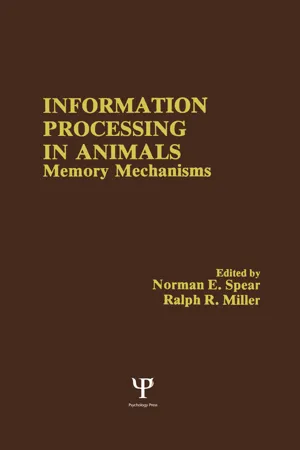Variable-Rehearsal (Priming) Theory
The central thesis has been that the immediate behavior, as well as the learning, occasioned by an external stimulus is dependent on the course of “active” representation of the stimulus in a short-term memory (STM) store. The more active the representation at some moment, or the longer active during some episode, the more vigorous will be the subject’s immediate response, the more persistent will be evidence of memory for the stimulus, and the more associative learning may be witnessed between the stimulus and other contemporaneous events (Wagner, 1976, 1978). Added to this thesis was the notion that two states of activation in STM could be distinguished, an especially active state (dubbed “rehearsal,” after the terminology of Atkinson & Shiffrin, 1968) and a less active state (given no special label). Then, it was importantly assumed that, whereas the presentation of a stimulus de nova normally would lead to a state of rehearsal of its representation in STM, the presentation of a stimulus that was already represented, or “primed,” in STM would not provoke this specially active state (Wagner, 1976, 1978).
Following this reasoning, it was possible to rationalize a considerable number of phenomena, in which a stimulus may be seen to be less effective than it otherwise would be, if it is preceded by a recent instance of the same stimulus or by some associatively related stimulus. The prevention of stimulus “rehearsal” due to the priming of STM could account for such phenomena as the short-term refractorylike effect in studies of habituation (Davis, 1969; Whitlow, 1975), the “conditioned diminution of the UR” in Pavlovian conditioning (Kimble & Ost, 1961; Kimmel, 1966), the less persistent memory of signaled versus unsignaled samples in a short-term memory paradigm (Terry & Wagner, 1975), and the apparent decrease in the associative learning occasioned by a signaled US in studies of “blocking” in Pavlovian conditioning (Kamin, 1969).
Problems of Indeterminancy
By this time there are a considerable number of analytical studies (e.g., Best & Gemberling, 1977; Pfautz & Wagner, 1976; Terry, 1976; Wagner, 1978) that further encourage the basic propositions. Nonetheless, it must be acknowledged that certain of the critical phenomena that have been listed are embraced by the formulation more in the sense of being allowed than being necessarily predicted.
Consider, for example, the phenomenon of the “conditioned diminution of the UR,” which is a reduction in the amplitude of the response following a US, when preceded by an associated CS than when presented alone. It is supposed that responding at the time of a US is determined finally by the degree of activation of the US representation that is provoked in STM. If a CS produces some measure of US representation prior to the US occurrence, it is assumed that the US itself will be less likely to produce a “rehearsed” representation and thus be less likely to provoke its usual response. But what is indexed in behavior is presumably not just this effect but the combined action of the CS and US. Will the total US representation in STM be less, immediately following a CS-US sequence, than following a US-alone presentation? Only on the possibility that what US representation in STM is instigated by the CS to provoke responding (as witnessed, for example, in some CR) is more than offset by the loss in contribution of US representation in STM by the US. The priming theory allows that this may happen and that a “conditioned diminution of the UR” may then be observed, but it does not necessarily predict it.
The same reasoning can be followed in regard to a phenomenon reported by Terry and Wagner (1975). A US was used as a sample in a short-term memory paradigm. If a US were presented, then one reinforcement contingency was in effect for a vibrotactual cue presented 2, 4, 8, or 16 sec later. If a US were not presented, then an opposite contingency was in effect. With such training, subjects learned to respond differentially to the vibrotactual cue depending on the prior presence versus absence of a US, and performed less accurately the longer the interval between the sample and the vibrotactual cue. The major observation was that if the US were preceded on test trials by a CS with which it had otherwise been paired, there was a reduction in its behavioral control at the time of the vibrotactual cue. An “expected” or “primed” US did not appear to be as memorable several seconds later as an “unexpected” or “unprimed” US. Terry and Wagner (1975), however, also reported an important ancillary observation. The CS that was otherwise paired with the sample US, when presented alone as a substitute sample, controlled delayed responding in the same direction, only to a lesser degree than did the US. It appeared that either the CS or the US could provoke a representation of the US in STM. If a CS → US sequence was less memorable than a US alone, it had to be because the positive contribution by the CS was more than offset by the attendant loss in contribution by the US. The priming theory clearly allows that this may happen but does not necessarily predict it.
These two example cases are not unusual.1 Our theorizing has emphasized a particular presumptive effect of priming of short-term memory, a decreased likelihood of rehearsal that should decrease evidence of stimulus processing. In many circumstances the same manipulations of priming should be expected to have other effects that would appear to complement stimulus processing. Although we can be encouraged that the former effect has been detected (Kimble & Ost, 1961; Terry & Wagner, 1975) in spite of the latter possibilities, a determinate theory must acknowledge both. SOP is an attempt to do this. Because the more compreh...
